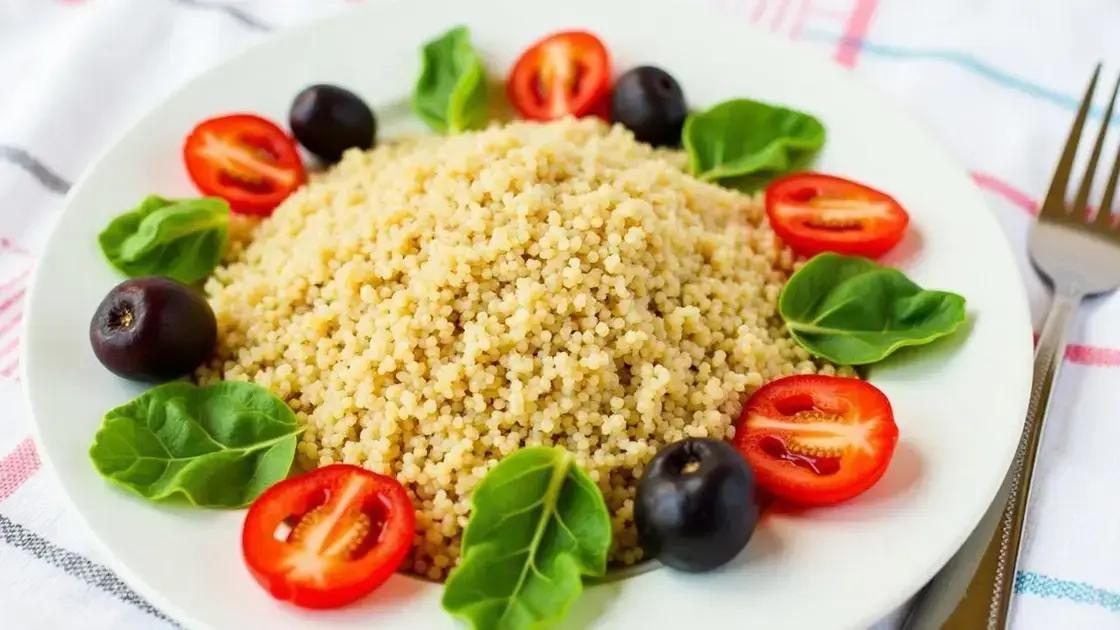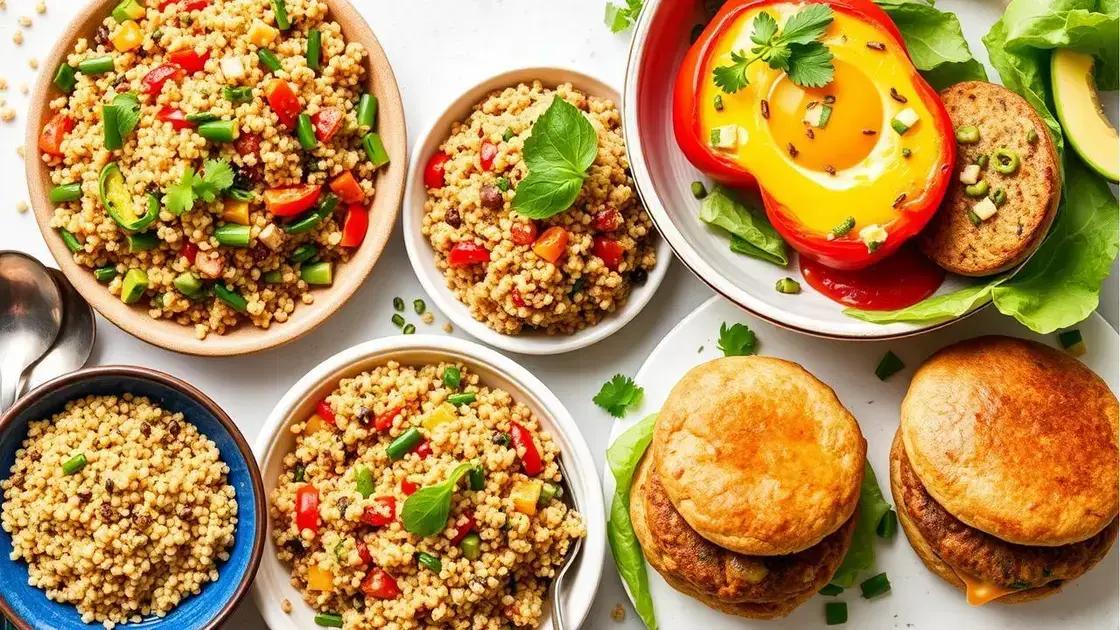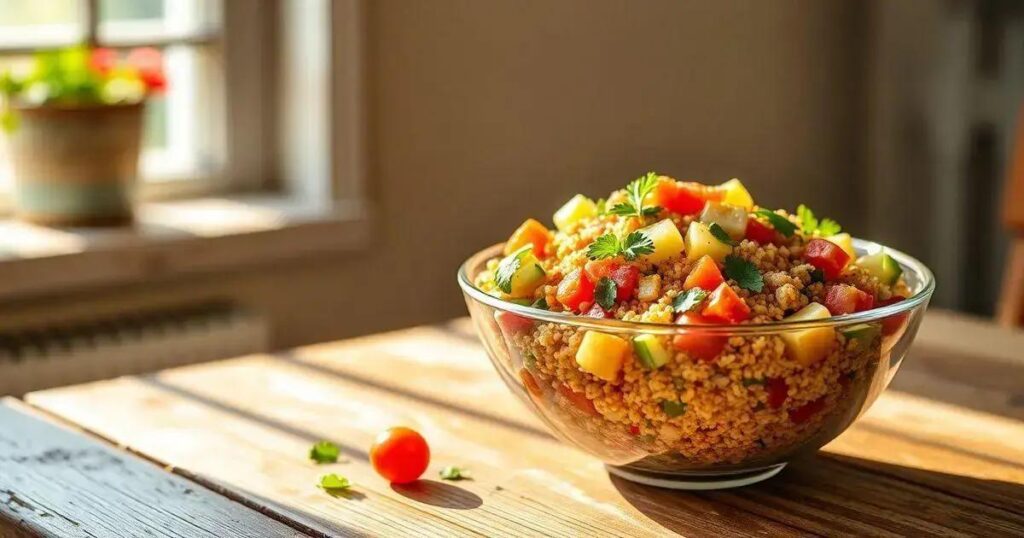The benefits of quinoa for balanced energy levels include its role as a complete protein, its ability to stabilize blood sugar due to a low glycemic index, and high fiber content, making it an ideal choice for sustained energy. Quinoa can be easily incorporated into various recipes such as salads, breakfast bowls, stuffed peppers, and veggie burgers, enhancing both nutrition and flavor in your diet.
Quinoa is often hailed for its numerous health benefits, especially when it comes to balancing energy levels. This superfood is not only rich in protein but also provides essential amino acids and a wealth of nutrients. In this article, we will delve into the specific advantages of quinoa in stabilizing energy, its nutritional profile, and several tasty recipes to enjoy this versatile grain.
What is Quinoa and Its Nutritional Profile?

Quinoa is a seed that is often classified as a grain, and it is renowned for its remarkable nutritional profile. Originally cultivated in the Andean region of South America, it is now popular worldwide for its health benefits. Unlike many grains, quinoa is a complete protein, which means it contains all nine essential amino acids that our bodies cannot produce on their own.
Nutritional Profile of Quinoa
One cup of cooked quinoa contains approximately 8 grams of protein, 5 grams of fiber, and a rich array of vitamins and minerals. Some key nutrients found in quinoa include:
- Magnesium: Essential for muscle function and energy production.
- Iron: Vital for transporting oxygen in the blood.
- Potassium: Helps regulate fluid balance and nerve signals.
- B Vitamins: Important for energy metabolism.
- Antioxidants: Protects the body from free radicals.
In addition to being gluten-free, quinoa is versatile and can be incorporated into various dishes, making it a perfect choice for those with dietary restrictions.
Why Choose Quinoa?
Choosing quinoa over other grains can be beneficial for energy levels. Its unique combination of protein and fiber not only helps keep you full but also stabilizes blood sugar levels, preventing the energy crashes often associated with simple carbohydrates. This makes quinoa a fantastic option for maintaining sustained energy throughout the day.
How Quinoa Stabilizes Blood Sugar Levels

Quinoa plays a significant role in stabilizing blood sugar levels, making it an ideal food choice for maintaining consistent energy throughout the day. Unlike simple carbohydrates that can cause spikes in blood sugar, quinoa is categorized as a low glycemic index food. This means it releases glucose into the bloodstream gradually, rather than all at once.
How Quinoa Helps Control Blood Sugar
The fiber content in quinoa also contributes to its blood sugar-stabilizing properties. One cup of cooked quinoa contains about 5 grams of fiber. Fiber delays the digestion process, leading to a slower conversion of carbohydrates into glucose. This slow digestion helps prevent sharp increases in blood sugar levels after meals.
Additionally, quinoa is rich in protein, which can further slow down the absorption of sugar into the bloodstream. Protein helps to balance the carbohydrates consumed, which adds to quinoa’s effectiveness in blood sugar management.
The Impact of Quinoa on Diabetes
For those managing diabetes or looking to maintain healthy blood sugar levels, incorporating quinoa into your diet can offer significant benefits. Studies suggest that whole grains like quinoa can help reduce the risk of developing type 2 diabetes.
Including quinoa in balanced meals not only supports blood sugar stability but also contributes to overall health, helping to maintain energy and vitality.
The Role of Quinoa in Boosting Energy

Quinoa is not only a nutritious food but also plays a vital role in boosting energy levels. Its unique combination of protein, fiber, and complex carbohydrates makes it a perfect food for sustaining energy throughout the day. Unlike white rice or bread, quinoa’s complex carbs digest slowly, providing a steady release of energy rather than a quick spike followed by a crash.
The Energy-Boosting Nutrients in Quinoa
One of the main reasons quinoa is excellent for energy is its high protein content. With about 8 grams of protein per cooked cup, it is one of the highest protein sources among grains. This protein helps repair muscles and keeps you feeling full, allowing for more consistent energy levels.
Furthermore, quinoa contains B vitamins, particularly B1 (thiamine), B2 (riboflavin), and B6, which are essential for energy production. These vitamins help convert food into fuel, giving your body the energy it needs to function efficiently.
How to Incorporate Quinoa for Energy
To harness the energy-boosting benefits of quinoa, it can easily be added to various meals. Consider using quinoa as a base for salads, mixing it with roasted vegetables and protein sources like chicken or tofu. You can also make breakfast bowls with quinoa, topped with fruits and nuts for a nutritious start to your day.
By including quinoa in your diet, you can enjoy sustained energy throughout your daily activities, promoting overall wellness and vitality.
Delicious Recipes to Incorporate Quinoa

Incorporating quinoa into your meals can be delicious and easy. Here are some tasty recipes to enjoy this versatile grain:
Quinoa Salad with Avocado and Black Beans
This refreshing salad is perfect for lunch or as a side dish. Combine cooked quinoa with black beans, diced avocado, cherry tomatoes, and cilantro. Drizzle with lime juice and olive oil for added flavor.
Quinoa Breakfast Bowl
Start your day off right with a quinoa breakfast bowl. Cook quinoa and top it with fresh fruit like berries and bananas. Add a sprinkle of nuts and a dash of honey for natural sweetness.
Stuffed Bell Peppers with Quinoa
For a hearty dinner, try stuffed bell peppers. Mix cooked quinoa with diced vegetables, such as zucchini and corn, and season with your favorite spices. Stuff the mixture into halved bell peppers and bake until tender.
Quinoa Veggie Burger
Create a flavorful veggie burger using quinoa as the base. Combine cooked quinoa with mashed beans, chopped onions, and spices. Form into patties and cook on a skillet until golden brown. Serve on a bun with your favorite toppings.
These recipes not only highlight the versatility of quinoa but also make it easy to enjoy its numerous health benefits.
Why Quinoa is Essential for Balanced Energy Levels
Incorporating quinoa into your diet can significantly enhance your energy levels and overall well-being. With its impressive nutritional profile, quinoa serves as a complete protein source while providing essential vitamins and minerals.
The ability of quinoa to stabilize blood sugar levels ensures a consistent energy release, preventing the dreaded crash often linked with other carbs. Whether you’re looking for delicious recipes, ways to boost your energy, or simply seeking a healthy food choice, quinoa checks all the boxes.
By exploring various recipes and understanding the multiple benefits of this superfood, it’s clear that quinoa should be a staple in your meals. Embrace quinoa for a more energized and healthier lifestyle!
FAQ – Frequently Asked Questions about Quinoa
What are the health benefits of quinoa?
Quinoa is a complete protein, rich in fiber, and packed with vitamins and minerals, making it great for boosting energy and promoting overall health.
How does quinoa stabilize blood sugar levels?
Quinoa has a low glycemic index and high fiber content, which slows down the absorption of sugar into the bloodstream, preventing spikes in blood sugar.
Can quinoa help with weight management?
Yes, quinoa’s high protein and fiber content can keep you feeling full longer, which may help reduce overall calorie intake.
What are some easy ways to incorporate quinoa into meals?
You can add quinoa to salads, make breakfast bowls with fruits, use it in stuffed peppers, or create veggie burgers for a nutritious meal.
Is quinoa gluten-free?
Yes, quinoa is naturally gluten-free, making it a suitable option for people with gluten sensitivities or celiac disease.
How do you cook quinoa?
To cook quinoa, rinse it under cold water, then boil with a 2:1 water-to-quinoa ratio for about 15 minutes until fluffy and water is absorbed.












